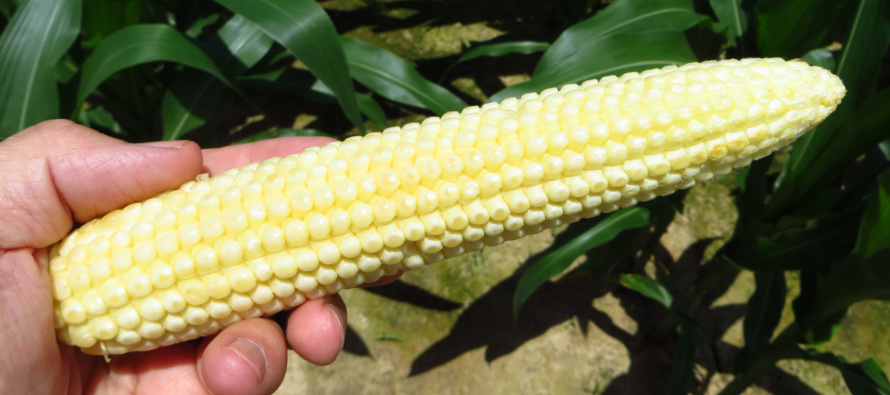Corn Reproductive Stages and Their Management Implications

Related Articles
- 2010 Soybean And Corn Variety Trial Data 3
- Evaluation of Peanut Prescription Rx Program in Mississippi 0
- Fertilizing Cotton with Poultry Litter 5
Latest Tweets
Corn reproductive stages may comprise nearly 60 days for full-season corn hybrids grown in Mississippi at normal planting dates depending upon seasonal heat unit accumulation. Early maturity hybrids (~110 day RM) will progress through reproductive stages slightly quicker, than our 118-120 day hybrids, but the difference during reproductive stages will only be about 5 days.
There are six commonly recognized corn growth stages noted with an R for reproductive growth, followed by a numeral designating subsequent stages.
R1: Silking
R2: Blister
R3: Milk
R4: Dough
R5: Dent
R6: Physiological Maturity
 R1 Silking
R1 Silking
Silking is defined when silks emerge from the ear to receive pollen and begin the fertilization process. Tasseling immediately precedes this growth stage, but essentially must coincide for successful pollination to occur. Corn is extremely sensitive to any stress which limits photosynthetic capacity at this time. This is because the kernels have very little ability to draw energy reserves from storage, because they are exceptionally small. The pollination process typically occurs in a relatively short (5-8 day) period and silks emerge slightly later than pollen shed initiation. Each ovule has a silk attached which grows outside the husk at the ear tip to receive pollen in order to fertilize a kernel. After successful fertilization, silks will detach from the ovule and dry and turn brown. Corn’s is extremely sensitivity to stress during the 20 day period from silking to milk stage and affects kernel number.
 R2 Blister
R2 Blister
Blister stage occurs after pollination, as white kernels begin to expand, but have not yet attained the plump appearance of milk stage kernels. After successful fertilization occurs and kernels begin to develop, silks dry out and turn brown during this stage. Thus, this stage is also often referred to as “brown silk.” This stage comprises a period centered about 10 days after silking.
R3 Milk
Milk stage (or commonly referred to as roasting ear) occurs about 15 to 21 days after silking as kernels develop a buttery yellow color and are full of milky white fluid. The cob will remain practically white through milk stage. Stress from pollination through milk stage will readily cause kernels close to the ear tip to abort, as energy is prioritized to the base of the ear. Ear kernel number is essentially determined by the conclusion of milk stage. Later, kernels progress through the dough stage, when kernels gain consistency and size, but remain soft and very moist.
 R4 Dough
R4 Dough
During a period about 22 to 28 days after silking, kernels transition through the dough stage, when kernels gain consistency and size, but remain soft and very moist. During the dough stage kernels gain consistency and the cob will attain a light pink color. Dough kernels will actually begin forming dents during latter stages, but remain a dull, matte appearance. Corn’s sensitivity to stress during the milk and dough stages is high and primarily affects kernel weight.
R5 Dent
Dent stage occurs around 30 days after silking when practically all kernels are fully dented and hard starch begins forming at the crown of kernels. If you grow an early-hybrid, this period may occur slightly quicker. Although it seems pretty simple, accurate identification of this stage can be confusing, which could create substantial issues with irrigation scheduling and termination, which can lead to yield loss. The best way to accurately identify dent stage is when the kernel crown turns the bright, shiny, dark yellow color of mature kernels and obtain a firm consistency, indicating the onset of hard starch development. Many kernels begin forming dents during late dough stage or R4, but full dent does not occur until hard starch forms at the top or crown of the kernel. Kernels mature from the outside-in (toward the cob) when hard starch begins developing at the crown. Kernels will fill about 50% of their potential weight and develop for about 24 or 25 days, if stress does not hasten maturity. Thus, this is far too early to terminate irrigation, as yield will suffer if hot, dry weather prevails. Early irrigation termination may also deteriorate stalk strength and promote lodging, because plants will cannibalize energy from vegetative organs to fill kernels. Corn’s sensitivity to stress during this period is generally moderate, but it becomes considerably more tolerant as it approaches physiological maturity.
 R6 Physiological Maturity
R6 Physiological Maturity
Physiological maturity is when kernel development is finished and “the crop is made.” It normally occurs about 24 days or slightly longer after dent stage in our environment. It is often identified by a “black layer” which develops when hard starch progression to the base is complete and the kernel is physiologically mature. Grain weight accumulation is complete at this stage. Vegetation and stalks will quickly die if hot, dry weather persists. Further management practices, including irrigation, herbicide application, etc… have no effect on the grain.






Let me tell You a sad story ! There are no comments yet, but You can be first one to comment this article.
Write a comment